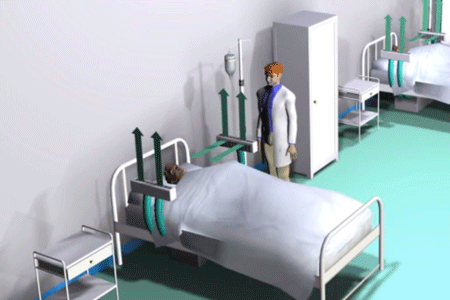A promising new ventilation system for hospital beds captures airborne infection and supplies patients with fresh air.
One of the biggest challenges at hospitals is to prevent the spread of infection from patients to other patients and/or health staff. The fear of an epidemic of SARS, swine flu or other airborne viruses has put authorities all over the world on alarm footing, but a solution may now be on its way.
A group of students is developing a new personal ventilation system for hospital beds. The system is fitted to the headboard of the bed, captures the air exhaled by patients and purifies it using a HEPA/ULPA filter. This is a filter designed to capture a high proportion of the small particles in the air—including bacteria and fungal spores, for example. The new system also uses UV radiation to neutralise viruses and other bacteria. The air is blown out again in such a way as to form a controlled flow of air around the patient, thus preventing the spread of potentially harmful particles.
“The solution not only benefits hospital planning flexibility, but also increases patient safety in its ability to protect many more patients than previously against infection. The alternative comprises conventional isolation tents or simply placing patients in isolation rooms—an approach that is mainly used in only serious cases at present,” explains Mattias Ingerslev, who is currently working on the final part of his MSc Eng course in Design and Innovation. He continues:
“The goal is for the system to reduce the number of people who pick up an infection while hospitalized. Personal ventilation around hospital beds will also enable hospitals to reduce the level of background ventilation and thus cut their total energy consumption.”
Mattias Ingerslev’s involvement in the project began a little over a year ago when he took the ‘Innovation in product development’ course at DTU Mechanical Engineering.
“We were a team of students from Copenhagen Business School (CBS) and DTU who met up regularly at DTU Skylab which served nicely as a prototype workshop,” he says, before adding:
“It was also at Skylab that I made a lot of useful, relevant contacts and became aware of the opportunities that exist in the area—such as a mentor programme, which I subsequently joined.”
Mattias Ingerslev is still a member of a small team that is on the point of taking the next step. The project is so promising that it has received a grant from DTU for the next phase: development of a fully functional prototype for testing in a laboratory with test subjects. Several companies have already expressed interest in the system, which was originally developed by two indoor climate researchers from DTU Civil Engineering, and patented in large parts of the world.
 |
|
The new ventilation helps prevent the spread of infection.
The system is fitted to the headboard of the hospital bed.
The air exhaled by patients is captured, and purified air is supplied for them to inhale.
A controlled flow of air is established around the patient, and this prevents potentially harmful particles from spreading.
|